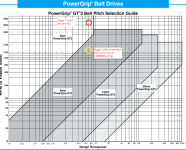nowholeself
1 W
I've been trying to design a gearbox around the Neumotor 8057 to drive the chainwheel from an all internal assembly a'la BBSHD. Every otherwise workable design I finish has the same unnacceptable flaw: it weighs a ton. However, I've been following an older thread on here involving a single reduction of this motor using a Gates GT2 belt system.
https://endless-sphere.com/forums/viewtopic.php?f=30&t=91144&hilit=8057
At first glance, a two stage belt reduction using a similar system seems like an excellent solution. Gt2 and 3 sprockets are readily available in aluminum. Belts are relatively light. And the first draft of the design is honestly simpler than anything yet: two-stages of 62:14, with the final sprocket bored for a spragg clutch around the bottom bracket axle, yielding a quiet and simple (roughly) 20:1 reduction.
Much more talented designers than me have not utilized such a system. So I have to be missing something. What is it? What am I missing? Why is this suboptimal? Surely my inexperienced 'duh just use two belts' is a headsmackingly dumb idea. But why? Roast me!
https://endless-sphere.com/forums/viewtopic.php?f=30&t=91144&hilit=8057
At first glance, a two stage belt reduction using a similar system seems like an excellent solution. Gt2 and 3 sprockets are readily available in aluminum. Belts are relatively light. And the first draft of the design is honestly simpler than anything yet: two-stages of 62:14, with the final sprocket bored for a spragg clutch around the bottom bracket axle, yielding a quiet and simple (roughly) 20:1 reduction.
Much more talented designers than me have not utilized such a system. So I have to be missing something. What is it? What am I missing? Why is this suboptimal? Surely my inexperienced 'duh just use two belts' is a headsmackingly dumb idea. But why? Roast me!


